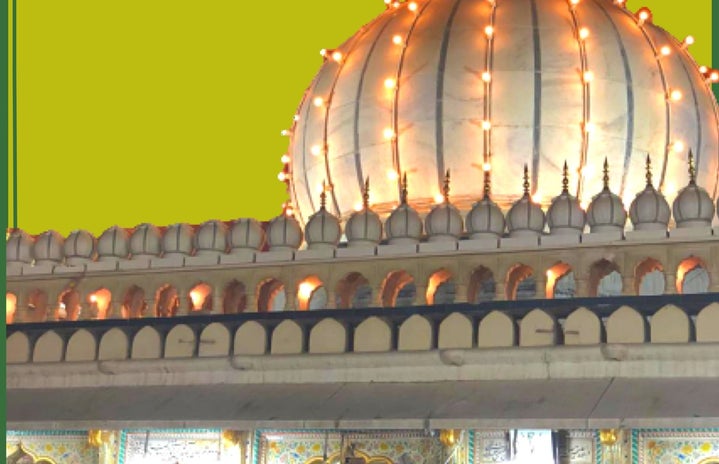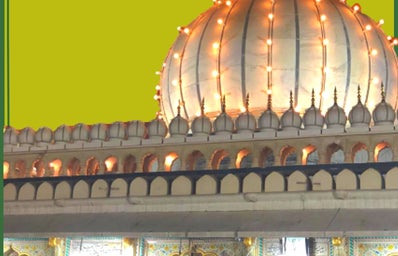Edited by Sanjana Hira
“Sab Auliya ji ki dargah dekhne door-door se aate hain. Lekin, bohat hi kam log yeh jaante hain ki Auliya ji apne samay mein lagbhag har din Bibi Fatima se milne aate the. Woh inko apni badi behan samaan maante the. Yahan tak ki, yeh dargah bhi Bibi ke dehaant ke baad unhone hi banwayi hai.”(People from faraway places come to see Nizamuddin Auliya’s dargah, but they are unaware that Nizamuddin Auliya himself used to come and visit Bibi Fatima almost every day when they were alive. He used to consider Bibi Fatima as his elder sister. Moreover, he was the one who got her shrine built).
Holding the jaali at Bibi Fatima Sam’s Dargah
Bibi Fatima Sam’s dargah is located in the interiors of the residential complex in Kaka Nagar, and reaching there is not an easy job. The roads emulating a jalebi (an Indian sweet, spiral in shape) explain why Haji Abdul Rasheed, the caretaker of the dargah had said, “Yahan sirf wohi aata hai, jinhe Bibi Fatima khud bulava deti hain.”(Only those people come here, who are personally invited by Bibi Fatima). Opening the rusted metal gates to the white marble compound, there was not a single person in sight. The screeching of the see-saw and the swings could be heard alongside the laughter of children playing in the NDMC primary school building adjacent to the dargah. The chirping of the birds which resided in the tall Peepal and Amaltas trees could be heard, occasionally interrupted by the ‘tring-tring’ of the bell on the cycles and rickshaws, and the horns of the cars. Even though it was a warm and dry day in the month of March, there was an unusual coolness inside the mausoleum. Heavily dependent on the natural sunlight, with a simple tube light here and there, the insides were dimly lit. On one side of the hall, there was a string of earthen water pots kept to provide water to whomsoever came asking for it. The arched niches, the carpets, the chadars(cloth), the clean floors, and the glass chandelier together created a peaceful ambience. On the tomb of the female Sufi saint, Bibi Fatima Sam, a golden chadar was laid out. The tomb was daily decorated with fresh rose petals, the scent of which embellished the entire area.
Haji Abdul Rasheed was more than keen to talk about the female Sufi. Shedding light upon her relationship with Hazrat Nizamuddin Auliya, he said, with a sense of pride, “Hazrat Nizamuddin Auliya ko Baba Farid ne inhi ke havale kiya tha. Nizamuddin Auliya ki umar kam thi, isliye Bibi Fatima ne hi unki dekh bhaal kari.”(Baba Farid gave her the responsibility of Hazrat Nizamuddin Auliya. She is the one who looked after him). He further went on to say, “Hazrat Nizamuddin Auliya laakhon logon ko langar khilaya karte the. Unke yahan langar mein sab banta tha- bakra bhi, murga bhi, par woh khud yeh sab nahi khaate the, woh sirf inke haath se hi bani rotiyan khaate the.” (Hazrat Nizamuddin Auliya used to hold a community kitchen for lakhs of people. Everything ranging from mutton to chicken was cooked here. But he himself did not eat any of this. He only ate what was cooked by Bibi Fatima herself). Haji Abdul Rasheed then told me to go and hold the ‘jaali’ (marbled lattice) tightly and wish for anything that I want. He suggested that I should go and spend some time alone with Bibi Fatima. Doing exactly that, with my eyes closed and hands clung on to the ‘jaali,’ I was aware of each breath inhaled and exhaled. The noiselessness overpowered the commotion of the mind and led to a state of thoughtlessness. The silence of the sanctum of Bibi Fatima Sam and the proximity between her shrine and me, truly got me closer to fulfilling the acclaimed aim of Sufism, that is, to share a direct personal experience with God.
Aysha A. Hidayatullah talks about the emotions of ‘Ruhaniyat’ (soulfulness), ‘sukoon’ (peace), and ‘qurbat’ (closeness) in her book “Feminist Edges of the Qur’an”. These were the emotions that dominated my mind as I exited the premises of the dargah. The dargah emits a divine gravitational pull which leaves a lasting imprint on your memory, making it nearly impossible for you not to revisit it.
I would have never ended up at Bibi Fatima Sam’s dargah had it not been for Aayat Khan, a seventy-two-year-old woman who I had met at Hazrat Nizamuddin Auliya’s Dargah, purely by chance.
Peeking through the jaali at Hazrat Nizamuddin Auliya’s Dargah
The Nizamuddin Basti is located in the south-central part of New Delhi. Eateries, small and large shops, public toilets, rickshaws, motor bikes, vendors on foot, dogs, herds of sheep, residential houses, and the visitors, co-existed on the narrow streets. Each lane in the basti (slum) was heavily ornamented with bright yellow decoration lights and silver and green festoons. An ongoing competition to dominate and overpower the other was evident between the two main attractions, namely the qawwali and the korma. The Thursday qawwali, which attracted a footfall of approximately 1,00,000 , is a form of devotional Islamic music on Sufi verses – a practice initiated by Hazrat Nizamuddin Auliya itself. The korma, on the other hand, is a spicy curry, sold at most of the eateries there.
Walking towards the dargah of Hazrat Nizamuddin Auliya, one feels as though a one-of-its kind potpourri has been placed right in front of the nose. With the first sniff, the aroma of the cumin, red chilli powder, and saffron hits the nostrils and makes it nearly impossible to not succumb to the sin of gluttony and spend Rs.110 on the mutton biryani. The next smell is that of the ittar, or perfume, stored in tiny glass bottles, emanating fragrances of fresh rose petals, and sold at the mere price of Rs. 30. The smell that followed, of the goats and chickens, with a questionable future, was unfortunately not so pleasant. A string of tiny shops, on both sides of the road, were selling rose petals and colorful chadars as offerings, polychrome clocks, incense sticks, and pictures of Mecca. All shops offered the service of storing shoes, since the holy shrine had to be explored barefoot.
Jostling my way through, the romanticized image of the dargah in my mind, created by the song ‘Kun Faya Kun’ by A.R. Rahman from the movie Rockstar, was shattered in a moment. The phrase,“Behen ji, zara side ho jaiye aur jagah dijiye!” (Please move to the side and give space to others) was overpowering the sound of the weekly qawwali. One would expect to enjoy the anonymity in the river of people, who were all flowing to the same direction, that is, towards the shrine of Hazrat Nizamuddin Auliya, but unfortunately, this was not the case. Women were identified from men as soon as they stepped on the wet marbled ground of the dargah. Why is that? Because the way the two genders are allowed to express their devotion towards the Sufi saint is starkly different. The men have the ‘sacred permit’ to go and witness the grandeur of the resting place. Women, on the other hand,, have to admire the shrine’s beauty and express their devotion through the jharokas (trellises) decorated with a large number of red threads, each representing the mannats (wishes) of different hopeful people. Out of curiosity and a strand of rebellion, my mother, who was my co-traveler, went and stood in the queue of men lined up outside the sanctum. The stares she received were belittling to say the least. Saafir Hafeez, a man standing in front of us, ‘politely’ commanded, “Madam, yahan ladies ka andar jaana mana hai.”(Madam, women are not permitted to go inside here). He continued and offered, “Agar aapko chadar aur phool chadhane hain, toh main aapki taraf se andar le jaata hoon.”(If you want to give flowers and chadar as offering, I can take it inside on your behalf). I retorted with a sense of disappointment, “Lekin aurtein andar kyun nahi jaa sakti? Ajmer sharif mein toh allowed hai”(But why can’t women go inside? It is allowed at Ajmer Sharif). Saafir raised his eyebrow and looked at me as though I had questioned the very sanctity of the dargah. Quite discourteously he responded, “Aap agar andar jayengi, toh qabr mein jo aaram kar raha hai, woh aapke kapdo ke bheetar dekh sakta hai. Kya aapko achha lagega? Hum toh aapki bhalayi ke liye hi keh rahe the.” Realizing that Saafir did not want to answer any further questions, I complied and went to the area reserved for ladies.
Many women – ranging from a newborn whose mother had got her to meet the saint to procure his blessings all the way from Muzaffarnagar, in Uttar Pradesh, to an ailing old woman who had come to meet with the Sufi saint one last time, were present. We sat there, peeking through the jharokas whilst some recited their holy sermons. We had accepted the bigotry and dogmatism imposed on us with ease. There was nothing unusual about this segregation of genders to us.
This was the moment when Aayat ji introduced herself. She had witnessed my squabble with Saafir earlier, and exclaimed how she understood my concerns. In her long life of seventy-two years, she had questioned various norms which were enforced upon her, but not once had she received a convincing answer. She introduced me to the concept of ‘wahdat ul wajood’. It refers to the unity of being or the oneness of existence. One of the primary aims of practicing and devoting one’s life to Sufism was the union with the divine, and the establishment of a direct intimate relationship with God. Such a pure bond between the seeker and the sought should not leave ground for any being to be disqualified from such a pure pursuit merely on the basis of gender. The spiritual world does not believe in the duality of beings, but evidently the material world does. Hence, the corrupt implementation of the schools of thought of Sufism clearly do not resonate with the original ideas. The conception and perception of the divine has been eroded over the years. Aayat ji had further exclaimed, “Hum toh yahan sirf apne mardon ke liye aate hain. Jab humein dil se koi mannat maangni hoti hai, toh hum Bibi Fatima Sam ke dwaar pahunch jaate hain. Agar aap chaahein, toh aap bhi wahan chale jaaiye. Yahin se kuch 5-10 minute ki doori par hi hai.”(We come here only because of our men. When we have to wholeheartedly wish for something, we go to the doors of Bibi Fatima Sam. If you want to, you should also go there. Its just 5-10 minutes away). Thus, I ended up at Bibi Fatima Sam’s dargah.
The contrasting encounters with Sufism in New Delhi leaves the woman traveller with a bitter-sweet aftertaste. An English translated version of Akhbar-ul-Akhyar claims that Hazrat Nizamuddin Auliya had once said, “When a lion emerges from a forest, nobody asks about its gender. The progeny of Adam should adopt piety and obedience to God whether they are men or women” . If a female Sufi saint could be so highly regarded and cherished by the highly acclaimed Hazrat Nizamuddin Auliya, why could his followers not do the same with a woman traveller when at his dargah? The very jaali which posed as a barrier between the female devotee and the shrine of Hazrat Nizamuddin Auliya, was what became the means for her to feel as close as she possibly could to the Sufi saint Bibi Fatima Sam.


